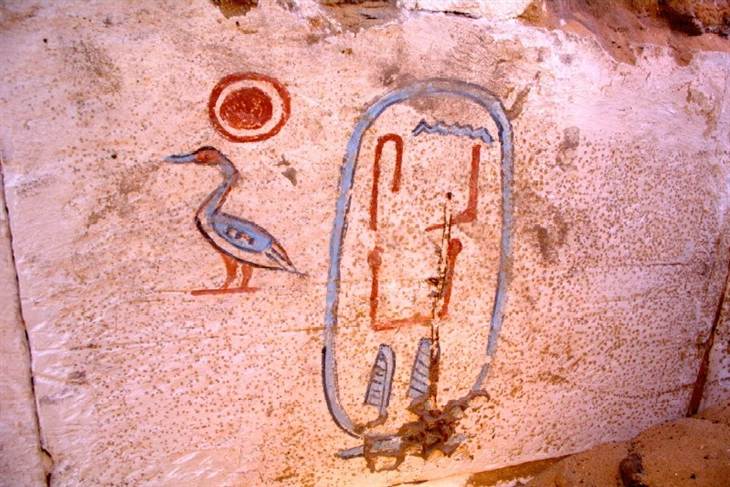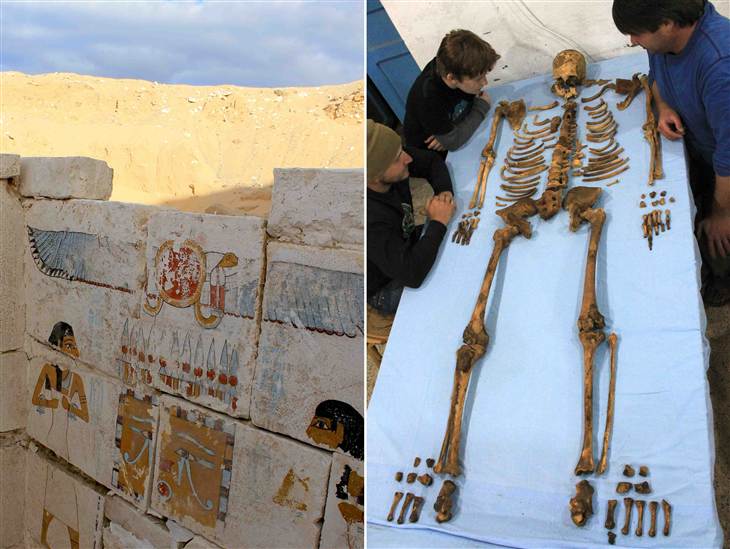The discovery of a new Egyptian tomb at Abydos has been hitting the news this last week – see for example http://phys.org/print309008810.html. The discovery of a tomb an of Egyptian king of the Second Intermediate Period is not necessary going to set the world alight – but the existence of this line of kings, contemporary with the Hyksos ensconced in the delta region, was apparently unknown.

The above is the hieroglyphs Gary Gilligan links to www.theguardian.com/science/2014/jan/22/archaeologists-remains-unknown-p… … points to a third contemporary dynasty during the Hyksos era – which is not too much of a surprise. See also www.nbcnews.com/science/mystery-pharaoh-his-tomb-identified-egypt-2D1193… … and Gary refers to the above hieroglyph reproduction, the winged disk and two eyes on the wall which appear to have eleven comet like objects nearby (he says). See what you can spot. Eleven tailed objects or eleven trees or what?
Gary Gilligan links to www.theguardian.com/science/2014/jan/22/archaeologists-remains-unknown-p… … points to a third contemporary dynasty during the Hyksos era – which is not too much of a surprise. See also www.nbcnews.com/science/mystery-pharaoh-his-tomb-identified-egypt-2D1193… … and Gary refers to the above hieroglyph reproduction, the winged disk and two eyes on the wall which appear to have eleven comet like objects nearby (he says). See what you can spot. Eleven tailed objects or eleven trees or what?
At http://www.jordantimes.com/index.php?news=26973 … we hear that finds in the mid Jordan Valley region are causing a rethink of patterns of human settlement. The settlement of Pella began before the EB Age, contemporary with Uruk in Sumeria – and come to that, Tall el-Hammam on the Kikkar. It seems likely that early civilisation in what is now a semi arid situation was at least as influential as the irrigation agricultural settlements on the flood plain of Iraq. Bronze Age Pella, the next stage, ran in parallel to the Old Kingdom of Egypt. However, at around 2800BC Pella came to an abrupt halt – why? This may correspond with the uncertain phase towards the end of dynasty 3 in Egypt (or end of EB1 in Sumeria). It is thought that tectonic activity was to blame – but see also www.pasthorizonspr.com/index.php/archives/05/2012/exploring-pella-bronze… … where we learn Pella is situated 60m below sea level, in the Rift Valley. The surrounding landscape has plentiful archaeology – some of which goes way back into the Palaeolithic. In the Roman and Byzantine periods, around 550AD, the landscape was still being extensively farmed – and then it all went pear shaped (see also http://sydney.edu.au/arts/sophi/neaf/excavations/index.shtml
Pella goes back a long way – thrived during the Bronze Age, but like most sites in the Levant was periodically levelled by earthquake or suffered from destructions by fire. The advent of the Thutmosid Empire (dynasty 18) in Canaan left Pella on a frontier, which persisted all the way down to the Romans. An Amarna period earthquake flattened the temple once again. It was reconstructed on a different configuration. Pella was also flattened by earthquake at the end of the LB Age.
